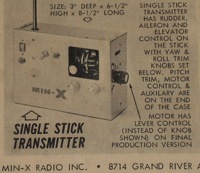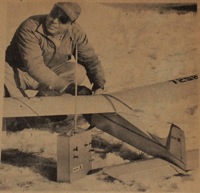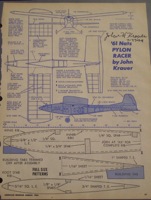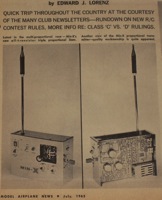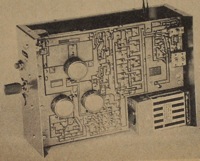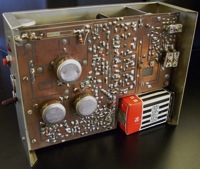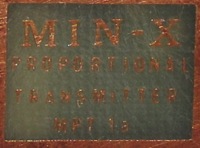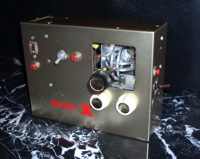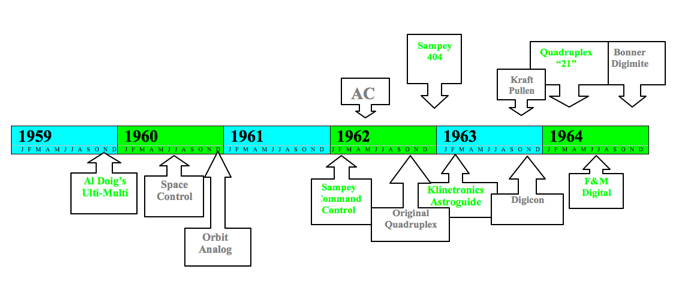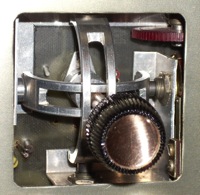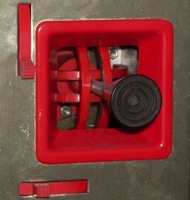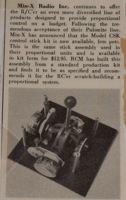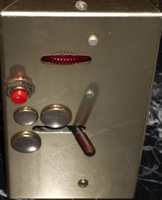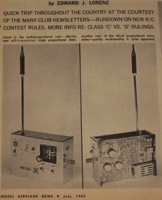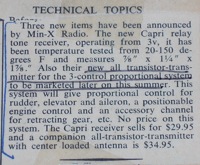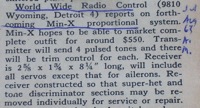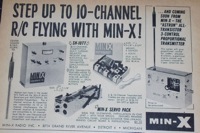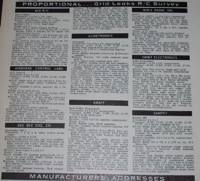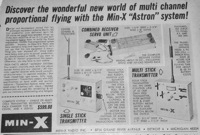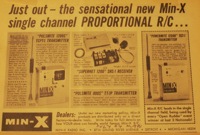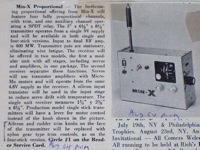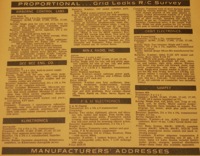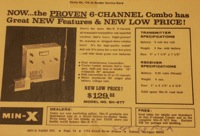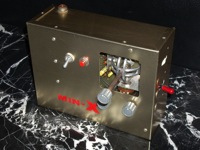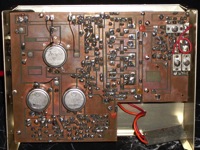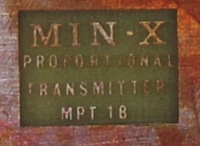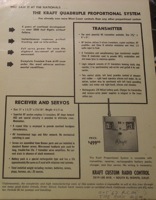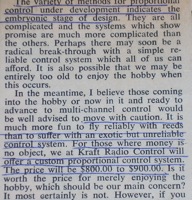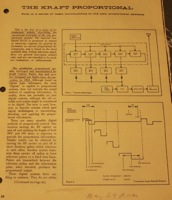Special Exhibit:
First Min-X Proportional
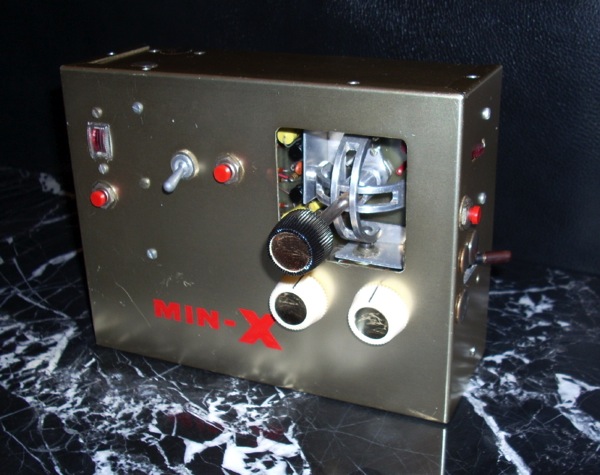
(Click on any of the images on this page to see a larger version)
This is the Min-X Astron. Introduced in July, 1963, Astron was a transistorized, analog proportional system. As Min-X’s first proportional offering, it was advertised nationally for over a year and became famous. Yet, mysteriously, we suspect not even one was ever sold. The first Min-X proportional actually available to the public (the “Astromite”, a digital proportional) would not appear until almost three years later, in February, 1966. We think we have solved this mystery as explained under “What Happened” below.
After decades of collector searches for the elusive Astron, some doubted it ever existed. Suspicion grew that the Astron was nothing but a mock-up, photographed for its many advertisements and publicity shots. Then we found it. In a barn. The experience was a little like discovering Amelia Earhart’s plane.
Here it is, the first and original Astron, the very one seen around the world in all the photographs.
The First Min-X Proportional.
Krauer’s Barn
The barn which sheltered the Astron for so many decades is in rural Michigan. It belongs to John Krauer. Who is Krauer? He was a model airplane star and electronics guru who designed all early Min-X radios. In addition to reeds, one of his biggest commercial successes for Min-X was a single channel transistorized receiver which may have been the first to break the Weight Barrier and rise above its heavy tube plus A&B battery predecessors. Krauer’s receiver only required 2 tiny pen cells, and was especially good at handling a pulse for Galloping Ghost. These receivers sold in large numbers—a financial hit for Min-X and a tribute to John Krauer.
Here’s a picture of Krauer flying his 8 channel Min-X in the winter of 1960/61:
Here’s the design for John Krauer’s pylon racer which earned second place at the 1961 Nationals:
Only problem was, John Krauer did not design the Astron. He says he had nothing to do with it and previous searches, including his barn, proved fruitless . How could Krauer’s barn harbor the coveted Astron without it being discovered for so many years and searches?
Sawdust.
The Astron was found a few feet from the ejection end of Krauer’s table saw. It was buried under a pile of saw dust generated over the years. After it was uncovered and dusted off, John Krauer still recalled no association with this historic radio beyond briefly test flying it.
Jack Lemon, who designed the Min-X Astromite (see Exhibit: Prototype Astromite) also swears he was not involved with the Astron and knows nothing about it. Two successive owners of Min-X including Jimmy Northmore himself, similarly say they know nothing about who designed the Min-X Astron and what became of it.
So what’s the story?
Positive Identification
The Astron made its debut in this July, 1963 Model Airplane News account. Fortunately, they included an inside as well as outside photo. This makes positive identification much easier. Here’s the same view of the circuit board today showing remarkably little change since 1963 despite what must have been numerous attempts to refine the system and get the bugs out .
Its hard to disagree with the author’s compliment on the quality workmanship. And the author knew what he was talking about; he was RC legend Ed Lorenz. Here’s a close up of the dark rectangular patch seen above the battery. Note this was the “a” model.
Changes to the outside include new knobs and removal of all function decals such as the NASA (and Sampey)-influenced “yaw” and “roll”. The final ad (below) depicts how Min-X made these alterations to prepare for production. The last ad also announces that production units will have a lever throttle instead of the flat toggle switch or the knob which replaced it in the same hole. The text for the 1963 article explained how this first version of the Astron had only 3 proportional channels (rudder, elevator and aileron) with throttle being merely positionable (like reeds) via the toggle switch and a fifth or auxiliary function available for landing gear. Imagine how this auxiliary functioned with only a single button.
All this evolution remains visible on the case of our Astron. You can see how the promised throttle lever was installed in a hand-made cut under the previous toggle switch. The toggle switch was replaced with a revolving knob for proportional throttle, as seen in the last ad, using the same hole. Then the knob and pot were removed and the hole was filled with yet another hole cap.
The red button for auxiliary function survives to this day and beneath it are 2 more capped holes which had already been plugged even in the first, 1963, pictures. A final hole cap is visible on the top near the front of the left side where the original antenna went in 1963. This corresponds with the position of the antenna in the first ads and reviews. A subsequent hole seen behind that was added later to accommodate a top-mounted antenna base when it became the Min-X standard.
The battery test and ouput meter were never changed (until the “B” model, below) and the on-off and start switches also remained the same. The separate “start” button was a peculiar feature of the earliest Sampey radios and seems even more odd here.
Here is the proportional timeline so you can judge just how early the Astron was with its July, 1963 debut.
Best Gimbals Ever
One highlight of the Astron was its unique gimbal & yoke mechanism. No other manufacturer made one like this, or ever would. Min-X invented this for the Astron to give it a competitive edge over other early proportional rigs. Although the Astron never made it off the ground, Min-X adopted its incomparable mechanism on all subsequent single channel pulse and full house digital systems.
Here’s a picture of the famous Min-x gimbal/yoke on its 1966 Astromite proportional. They used red plastic for cost savings, not these beautiful machined aluminum units pioneered on the Astron. In addition to using the unique Astron gimbals on all Min-X proportionals, the Company sold them separately for home builders and experimenters:
When RCM reviewed the Astromite in August, 1967, they said the Min-X trademark control stick gimbaling “is the best and most natural feeling stick centering in the business.” Other experts have noted how, after the stick is moved in one direction, a second direction comes with seeming magical smoothness and frictionless ease.Try one, and you’ll see. A second benefit of the Min-X system over other early proportionals was mentioned in RCM’s August, 1964 announcement of the Astron. They noted the Min-X gimbal enabled the rudder and elevator pots to be stationary thus eliminating wire fatigue. Other companies’ systems disturbed the wires each time the stick was moved, presenting a small risk of eventual breakage and loss of control.
These supurb mechanisms were designed and expertly machined by Sam Peterson. Sam also should be credited for creating Min-X’s reed banks. These were much smaller and lighter than competitor’s models.
It’s Alive!
We rigged a substitute battery and were pleased to note the Astron still works. On a tone monitor it broadcasts pulsed “music” like other analog proportionals. But the Astron music is quite distinct. We ran tests comparing the tone monitor sounds of the Space Control, Sampey, Quadruplex and Orbit Analog (Space Control circuit) full house and 3 + 1 systems. You can hear two of these yourself in our Video Gallery, Ed Rutherford demonstration, part II.
Compared to these contemporary or earlier systems which might have been copied by Min-X, the song of the Astron is markedly different. The tones are more pronounced with greater range and variation. The Astron’s pulse speed may exceed all of the others.
Unlike the Space Control, for example, all 3 flight functions (rudder, elevator, ailerons) have dramatic, wide ranging, audible tone variations and the throttle doesn’t appear to simply speed up or slow down overall rates. Unscientifically, the eerie “music” of the Astron bears some resemblance to that in early science fiction movies. These films employed “unearthly” electronic music to provoke a sense of awe and fear. While the Astron’s name was no doubt inspired by the U.S. space program , it may be fitting in other ways too.
The Astron’s throttle and auxiliary controls appear independent without overriding or neutralizing basic flight controls the way the famous Pullen Proportional and first attempted Kraft proportional did (see Exhibit:” First Kraft Proportional”). The auxiliary function was activated by the red button on the right side of the case at the level of the stick. Notice that this is a single switch and the hole below it for the opposite direction switch has been capped off since at least its first publicity photo in 1963.
The auxiliary function appears to project a fifth, extremely high pitch tone barely within the range of the human ear. Pressing the auxiliary button might have enabled a flyer to raise landing gear and attract dogs at the same time.
The start button next to the on-off switch appears to inject a jolt of juice which is instantaneous whether the button is promptly released or held down. Perhaps this helped initiate a ring counter or commutator function like the Sampey “start” button. The broadcast of the production or “B” model may be more like the Space Control. It is difficult to judge at this time, however, since output is feeble due to a damaged component (failing output transistor?).
It Flies!
And the Astron did fly. One reason we never gave up the Great Astron Search was accounts from President Jimmy Northmore and others of actual flight tests. No one could recall who designed the Astron or what became of it, but all remembered flying it.
Much of the flight testing occurred in Florida during the winter, when frozen Michigan weather made local testing impracticable. Reports consistently confirm the Astron worked and worked well. But never well enough to be commercialized.
Ads And Promotions
Here is the first public announcement of the Min-X Astron, July,63 MAN:
Note that this was promised to be available in the summer of 1963. Way too optimistic, it turned out.
Here is a subsequent report from Min-X distributor and neighbor World Wide Radio Control, Jul/Aug 63 A.M:
Note the price estimate of $550 . That would equal $ 3,818.00 in 2008 dollars! Inexplicably, this early account says there will be 4 pulsed tones with a trim control for each despite motor being not proportional or trimmable.
Here is the first advertisement for Astron, Sept/Oct 63 A.M:
This kicked off a series of identical ads run over the months which followed. Note that these ads state Astron will have only 3 proportional controls plus trimmable throttle. Note also how the Astron is always said to be “COMING SOON” and not actually in production or available yet.
In the winter of 1964 the Astron was displayed at the Buffalo Bison’s trade show and at the top show in the world—the annual Toledo, Ohio trade show. RCM reported that nine manufacturers had proportional systems but many were little more that concepts or experimental. At the Buffalo conference Min-X displayed its four stick version of the Astron designed to aid transition to proportional for reed flyers (see Exhibit: Citizen Ship 4 Stick). There was considerable debate across the country and, to a lesser extent, around the world, on whether the future of proportional would involve 1 stick, 2 stick or 4 stick transmitters.
The Sept/Oct 63 edition of Grid Leaks published a survey briefly describing all transmitters and receivers then available in the U.S. Here is the proportional section of the survey showing only 7 full house proportional systems then in production. Two of these are erroneous, the Min-X Astron and Kraft Pullen Proportional. They were not actually being sold then despite the good faith belief by both manufacturers that they surely would be selling by the time this issue reached the public.
Finally, in the May/Jun 64 A.M. this ad appeared trumpeting that the Astron had arrived, was actually in production and available for $599.88 (that’s a mere $ 4,111.00 in 2008 dollars):
Note that the Astron now looks very much as it does in our museum today. The ad’s picture shows all function decals (e.g. “on “off”) had been removed, the knobs changed and the motor toggle switch deleted.
This ad revealed the receiver servo brick for the first time and pictured the four-stick transmitter option. The ad said the Astron now had four proportional channels, as ours in fact does, and explained that the motor control knob will be replaced with a lever, also as seen on our Astron. They repeat the claim that each channel will have trim, but this time correctly excepting motor. Rudder trim is the left knob below the stick, aileron the right. Elevator trim was via the wheel on the upper right side of the case.
This same ad appeared in the June 1964 edition of MAN. Even more striking than its assertion that the first production units were delivered in April 1964 is the detailed explanation of why it took so long to reach production and how the delay was worth it. Only one problem. It wasn’t true.
Or was it? At this point it appears no Astrons were produced or sold, and we may have the only “production” model (described below). However, some of them may have been sold and will turn up some day. Please let us know if you are aware of any. Even if none were ever produced, it appears Min-X and its advertisers were honest and well-intentioned as explained below.
The next Min-X ad, published one month later, only mentions Astron in passing, July 64 MAN:
In the Jun/Jul RCM the editor printed the following revelation about announced proportional systems:
“ …most manufacturers are not delivering proportionals yet and probably won’t until next fall. The reason for this seems not to be the lack of a product to put on the market as it is in finding time to make them. Most proportional manufacturers also make reed equipment and have all the orders they can fill in this line. Apparently the profit is not great enough to warrant adding more production staff to turn out the proportionals.”
One month later, in the August 64 RCM this Astron announcement appeared:
Note that the status of the Astron is back to “forthcoming” instead of actually here. This review also disclosed that separate receiver/servo airborne systems would be offered as an alternative to integrated “bricks”. As Orbit proclaimed later, separate units provided more flexibility and facilitated installation in smaller planes. Finally, RCM divulged that the trim knobs would be replaced with nylon wheels. The advantage of such a modification is questionable and it appears it never occurred.
The September 1964 Grid Leaks survey of all proportional systems once again included the Astron as if it was actually available:
Note that the Astron is now described as a four channel proportional with a lever throttle. Oddly, the description also states “No start button is required” despite having one. The most dramatic change in this annual survey is something that’s not there. The Kraft Pullen Proportional. It has been deleted and Kraft is no longer listed as having any proportional system at all.
Min-X’s extensive advertising and promotion of the Astron then abruptly ceased.
In the next Min-X ad, and all that followed, the Astron is gone, Sept 64 RCM:
No Picture. No mention. Not “Coming Soon”.
Not coming ever.
Production Model
We call this the production model since it is clearly a later edition having the lever throttle (Min-X promised for production models) professionally installed as original equipment, instead of somewhat crudely added on as done with the first Astron. Thus, there is no hole in the case for a former throttle knob or toggle switch. Other evidence includes the “modern” antenna jack and location and absence of other holes in the case for prior antenna locations.
But the main reason we know this transmitter came later is its formal designation as the “B” model on its circuit board. Here is a picture of its circuit board and a close up of the identification section:
On the other hand, there are several reasons why this may not have been the production version. We don’t know whether there was any Astron production at all beyond this example, it lacks the nylon wheel trim tabs Min-X said would appear on production models and it lacks the meter, battery test and auxiliary control features—a step backward. The deleted features may indicate an attempt to reduce complexity and production costs to bolster profitability.
Its hard to imagine the need to withhold the useful meter and battery test capability in a system which would cost thousands of dollars today, but early proportionals were not highly profitable due to their labor intensive manufacture and their components (e.g. transistors) costing so much more back then. Discontinuing the fifth channel/function, however, is easy to understand since each channel added to an analog proportional (beyond the first 2) greatly increased its complexity and cost. Other than SPAR (See Manufacturer section:SPAR) ,what analog proportional ever had 5 channels?
What Happened?
What happened to the Astron? How could this promising proportional be nationally advertised by a reputable company as “COMING SOON” then as actually in production then just disappear without a trace? No one from Min-X seems to know. But its not hard to surmise what happened here. There were probably two main factors—Image Pressure and the Difficulty Gap.
Image Pressure
In the early 1960’s proportional RC was widely viewed as the coming thing and future of the hobby. Radio Control manufacturers were under tremendous pressure to show the public they were capable of this high tech. Having a cutting-edge proportional system made a company look like a serious player which would be around in the future and would have better engineered products generally.
This image helped companies sell bread and butter (profitable) radios like reed systems. Even if they never made any money on their proportional sets.
Even if they never made proportional radios at all.
Difficulty Gap
But highly-regarded companies like Min-X and its advertisers would not fake a proportional just to make money on other products. They all honestly believed their systems were “coming soon”, the “bugs” would soon be worked out and success was just around the corner. The problem was the yawning gap between their “can do”, optimistic engineer expectations and the reality that reliable proportional control would prove vastly more difficult to develop than any one at any company knew.
Due to publication lead times, advertisements had to be submitted months in advance. At the time Min-X submitted the final ad announcing the Astron had arrived and production begun, for example, they were probably CERTAIN that the remaining problems could EASILY be engineered out of the system in the months before the ad was actually published.
Kraft Too?
Min-X was hardly alone. The best example of another company being propelled by Image Pressure then embarrassed by the Difficulty Gap was Kraft Systems. Like Min-X, Kraft’s products were renowned for their quality and Kraft’s management for its integrity. And if Kraft had the proportional problem, how could any other manufacturer be faulted, since Kraft went on to become the undisputed king, the dominant RC manufacturer in the United States and the entire world. Yet Kraft had exactly the same problem introducing its first proportional—the Kraft Pullen Proportional.
Kraft worked on this system for years and kept the press and modeling public informed of its progress and that it was coming soon. Then three months after the Astron was introduced, Kraft ran a full page ad in the October 1963 RCM announcing its Pullen Proportional was finally available, for $499.95:
It wasn’t.
Six months later Phil Kraft vented his frustration over this in a revealing Grid Leaks article (May/Jun 64). For instance:
“For the past year production of our system has always seemed ’just 60 days or less away.’ Then another 500 or so test flights would show up a weak point and back to engineering went the system. Each time it grew more complex as reliability needs indicated changes. Finally, the system seems to be completed, but our original cost estimates proved much too low”
Even as Kraft wrote this illuminating explanation of the problem, he was still in its grip. The most he can say here--- six months after full page national ads offering the system for $499.95--- is that it finally “SEEMS to be completed” but even if it is now ready to sell, he warns, the advertised cost proved much too low. How much too low? Incredibly, Kraft concludes this article saying reed systems would be a better buy for almost all flyers, because the price for the Kraft proportional would be “$800.00 to $900.00” Nine hundred dollars is equivalent to $6,167.00 in 2008! At such a price even if the system was complete and reliable, it would not be commercially viable.
To compound Kraft’s embarrassment, a detailed review of the Kraft Pullen Proportional ran that same month in RCM and stated it was in production and available for $599.95. This appears just as incorrect as the October, 1963 full page ad, but research continues. For further details, see Exhibit: First Kraft Proportional.
As suggested by the forgoing the Difficulty Gap involved interrelated factors of complexity, reliability and cost. Analog and early digital systems were relatively complex with large numbers of components. This was often compounded by adding more components to engineer around deficiencies revealed in field tests. As component count and complexity went up the number of paths to failure went up as well, reliability sank correspondingly and costs soared.
So our best guess as to “what happened” is that Min-X, Kraft and others were propelled by Image Pressure to the edge of the Difficulty Gap—and then fell in.
Kraft didn’t climb out until production of the KP-4 in 1965. It took Min-X longer, finally producing its first commercially viable proportional in 1966—the Min-X Astromite. See Exhibit: Prototype Astromite.




